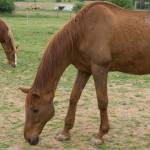Colic Caused by Stomach Distention is a Life-Threatening Condition

Colic is a fact of life for horse owners. Chances are very good that anyone who keeps several horses for several years will encounter colic at some time. Mild episodes may resolve on their own before a veterinarian can arrive, and more serious equine abdominal discomfort can often be managed with medication. Surgical intervention is available at clinics all over the country when it is deemed necessary for severe cases.
If colicky horses usually recover with no negative effects, why do horse owners still fear colic? The answer may be tied to the fact that there is no way to save a horse with certain conditions that begin with what seems to be a simple bellyache. Though fewer than 5% of colic cases are caused by problems in the stomach, rupture of this organ (a rare but very serious development) makes these cases significant.
Gross stomach distention can be caused by several factors. The most common are overconsumption of water or grain; parasite infestation; and any mechanical condition, such as a twisted intestine, that prevents food from moving out of the stomach. A horse that is deprived of water for an extended period of time may drink too much when access is restored. Ingesting a large amount of cold water can cause a temporary spasm of the pylorus (opening from the stomach into the small intestine) resulting in stomach distention and pain. This condition is usually fairly brief, and often resolves without the need for veterinary intervention.
Overeating of grain is another common cause of stomach distention. In a typical scenario, a horse is accidentally allowed access to the feed room, or a large quantity of feed is delivered and stacked in an area where horses can reach it. The horse’s stomach is relatively small, with a capacity of only about 2 to 4 gallons (8 to 16 liters). Because of this limited capacity, a horse can quickly eat more grain than the stomach can handle. If the grain stays in the stomach for an extended period, fermentation may occur, producing gas that contributes to distention and pain. Fullness also triggers waves of contractions designed to push food into the small intestine, increasing discomfort if the food is not able to leave the stomach. Most mammals that overeat are able to vomit to relieve the pressure of a full stomach, but due to the anatomy of the equine soft palate and epiglottis, vomiting is usually not possible for the horse. Stomach rupture can occur in rare circumstances where the stomach contents cannot move further into the digestive tract.
The impact of parasites on equine health is not as significant as it was before the development of inexpensive and easily used deworming preparations. Bot fly larvae spend part of their life attached to the lining of the stomach, where a light infestation usually does not significantly affect the horse’s health. Heavier parasite loads sometimes cause irritation or ulceration of the stomach, and perforation and peritonitis occasionally result. Horses that are not regularly dewormed may support bot larvae in sufficient numbers to block the passage of food out of the stomach, and gastric rupture has been reported in such cases.
Anyone who has observed a colicky horse will recall the relief to horse and handlers when the intense pain finally subsides. Usually this occurs fairly rapidly after a veterinarian administers an injection to calm the horse and relieve discomfort. A sudden cessation of colic pain is not always a positive development, however, as it may be a signal that the stomach has ruptured. The horse initially feels better because the pressure of an overfilled stomach is no longer causing pain, but will soon show muscle tremors, rapid weak pulse, fast shallow breathing, and dropping body temperature. A ruptured stomach is almost always followed by death within a few hours.
Although colic occurs even on farms that are carefully managed, some easy steps can be taken to decrease the chances of a serious incident.
1. Make sure horses have access to fresh, clean water at all times except directly after exercise when the horse is hot. Unless a horse has been unable to get to water for some time, he will usually not drink enough water to cause stomach distention. A hot horse should be given a chance to drink every few minutes throughout the cooldown period and should be walked until his temperature returns to normal.
2. Every precaution should be taken to prevent the possibility of a horse getting into an area where grain is stored. Fasteners on gates, barns, stalls, feed room doors, and feed bins should be horseproof and redundant. Make it a practice never to leave the feed room open, even for a few minutes.
3. Feed no more than five pounds of grain in one meal. If a horse eats more than five pounds of grain a day, break the total amount into two or more separate feedings. Make any changes in feed type, amount, or schedule over a period of several days.
4. Deworm on a regular basis. Consult a veterinarian for a suggested deworming schedule.
5. Because it is difficult for an untrained person to determine the cause of abdominal pain in a horse, it is strongly recommended that a veterinarian be called to examine and treat any horse showing signs of colic.








